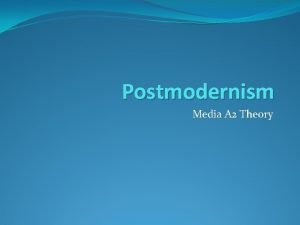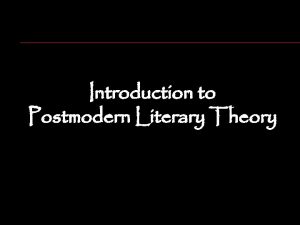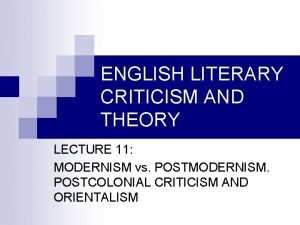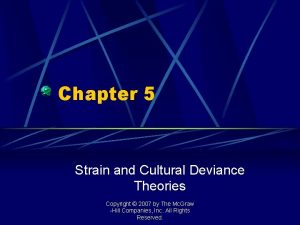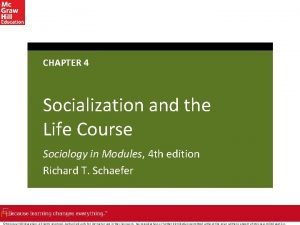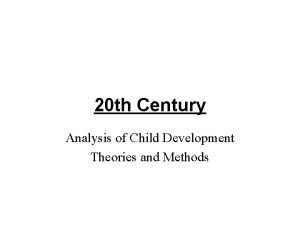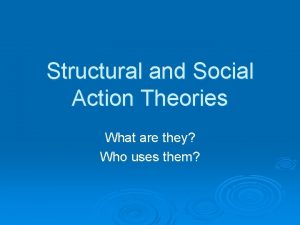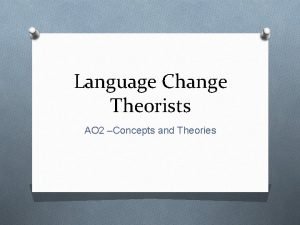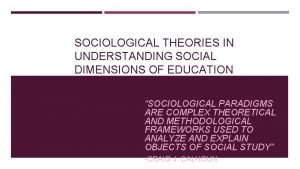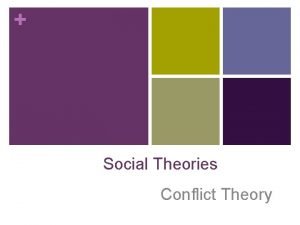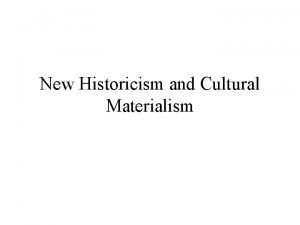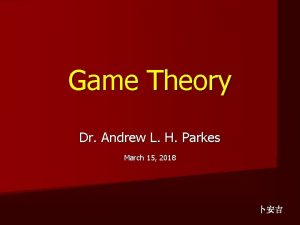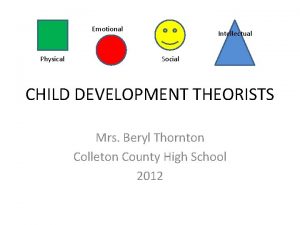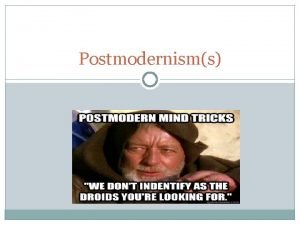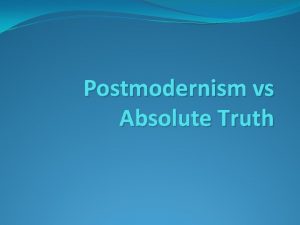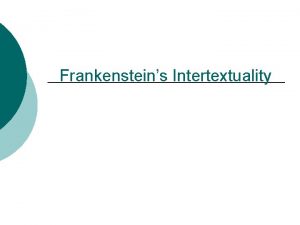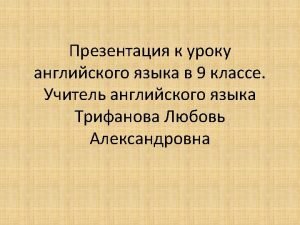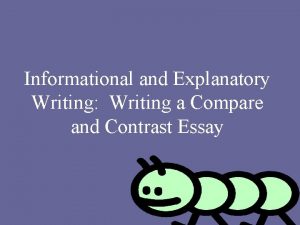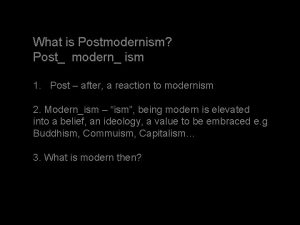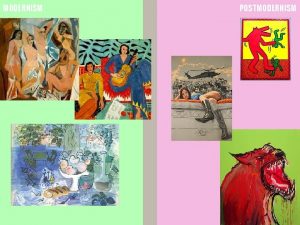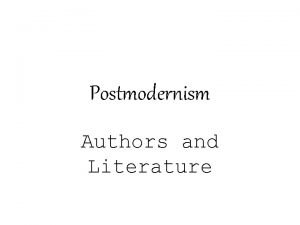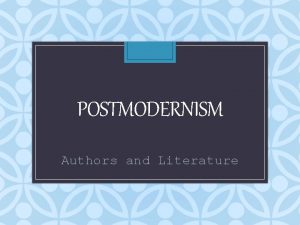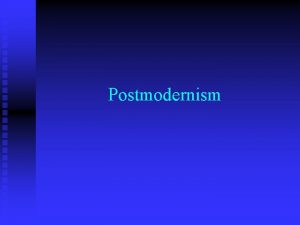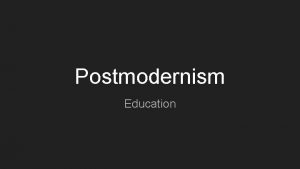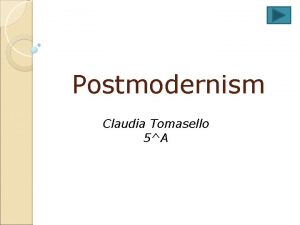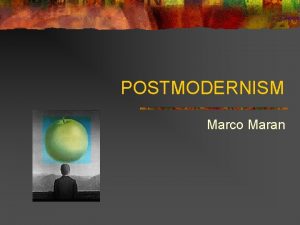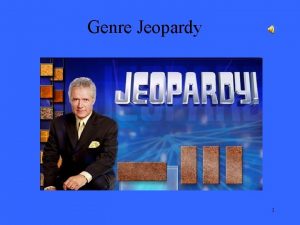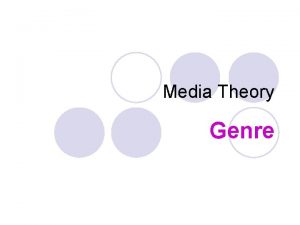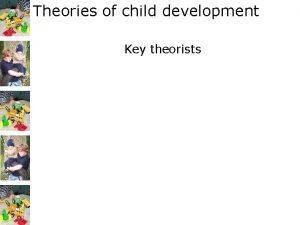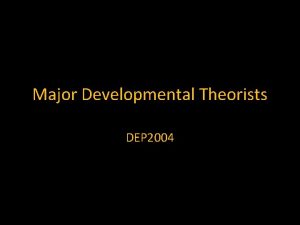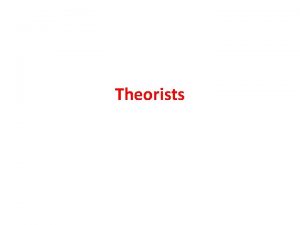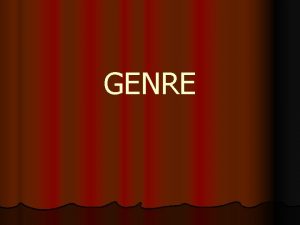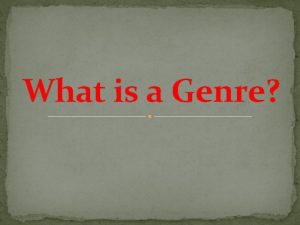Postmodernism theory theorists and texts Theories of Genre






























- Slides: 30

Postmodernism - theory, theorists and texts

Theories of Genre John FISKE American Professor of Communication Arts, 2000 s Fiske develops Barthes’ semic code: A representation of a car chase only makes sense in relation to all the others we have seen - after all, we are unlikely to have experienced one in reality, and if we did, we would, according to this model, make sense of it by turning it into another text, which we would also understand intertextually, in terms of what we have seen so often on our screens. There is then a cultural knowledge of the concept 'car chase' that any one text is a prospectus for, and that is used by the viewer to decode it, and by the producer to encode it. (Fiske 1987, 115)

Theories of Genre Roland BARTHES French semiotic theorist A scene from the Hollywood film ‘The Day After Tomorrow’

Theories of Genre Roland BARTHES French semiotic theorist A ‘real’ image of people fleeing the dust cloud in the aftermath of ‘ 9/11’

Theories of Genre Jacques DERRIDA French philosopher Jacques Derrida proposed that 'a text cannot belong to no genre, it cannot be without. . . a genre. Every text participates in one or several genres, there is no genreless text' (Derrida 1981, 61). Derrida is a structuralist and therefore this principle goes against postmodernist thinking.

Theories of Genre Jacques DERRIDA French philosopher Derrida’s point helps to explain why commentators on September 11 th could only understand what they were seeing as ‘like a movie’. This is perhaps what Fiske means by saying ‘we make sense of it by turning it into another text. ’ Compare this to what Fiske says about never having experienced a car chase. If we encounter a real-life genre experience the decoding system in our brains becomes confused.

Theories of Genre Claude LEVI-STRAUSS French structuralist, 1970 s Levi-Strauss developed the concept of bricolage Levi-Strauss saw any text as constructed out of socially recognisable ‘debris’ from other texts. He saw that writers construct texts from other texts by a process of: Addition Deletion Substitution Transposition

Theories of Genre Gerard GENETTE French structuralist, 1990 s Genette developed the term transtextuality and developed five sub-groups, but only 4 apply to film: • intertextuality quotation, plagiarism, allusion • architextuality designation of the text as part of a genre by the writer or by the audience • metatextuality explicit or implicit critical commentary of one text on another text • hypotextuality the relation between a text and a preceeding hypotext - a text or genre on which it is based but which it transforms, modifies, elaborates or extends (including parody, spoof, sequel, translation) Which of our viewed films give examples of each type?

Postmodernist Theory Postmodernist theory grows out of and extends modernist and structuralist thinking. Postmodernists might reject Derrida’s proposition that no text can be without a genre. Postmodernists take bricolage (Levi-Strauss) and the various intertextualities identified by Genette, extending their work into pure intertextuality that breaches the bounds of genre.

Non-postmodernist Theory Talcott Parsons Structural Functionalism Talcott Parsons was a sociologist in the 1950 s who made observations of society leading to the ‘structural functionalist’ view. This view suggests that society (like literature and film) has necessary structures that keep it together. Like Propp’s spheres of action, structural functionalism sees roles in society, particularly gender roles in the nuclear family. Structural functionalists believed that if roles were not fulfilled or changed then the structures would adapt, entrenching new roles and society would progress into the furure base on a new structure. Postmodernists reject structures and defined roles.

Postmodernist Theory The term ‘postmodernism’ was coined in 1938 by an English historian, Arnold Toynbee, after a term used by a Spanish historian Federico de Onis. Toynbee used it to mean the declining influence of Christianity and the Western nations post 1875. This is definitely not how it is used in current Media Studies. Jencks’ definition is nearer the mark: ‘Post-Modernism is fundamentally the eclectic mixture of any tradition with that of its immediate past: it is both the continuation of Modernism and its transcendence’ (Charles Jencks, What is Post-Modernism? , 1986).

Postmodernist Theory Marshall Mc. Luhan Some theorists see postmodernism beginning after the Second World War, when the major ‘modern’ political movements of Nazism and Communism were called into question by Western thinkers. Others date the movement to the 1960 s, notably to Marshall Mc. Luhan’s coining of the phrase: “The medium is the message, ” (1964). By this he means that the manner in which the message is mediated becomes more important than the meaning of the message itself. In a era disillusioned by the failure of great political hopes, by the holocaust and by the loss of influence of religion in Western society, mediation seemed set to fill the vacuum. Out of this grew the idea that theories were possible for how mediation works - how it is built (representations), how it influences audiences (hypodermic theory, uses and gratifications, male gaze), how it references itself (intertextuality). Previously, serious thought was reserved for the messages (religion, politics, philosophy) behind the mediation.

Postmodernist Theory Baudrillard developed the ideas of Mc. Luhan to the point where it is possible to deny that the message underneath the medium has any substance at all. Therefore, the audience comes to perceive through the media a world that appears ‘real’ but is not. In some ways this reflects what Rene Magritte painted in 1928 in his work called ‘The treachery of Images. ’ Magritte captions an arrangement of paint on canvas with the denotative words, “Ceci n’est pas une pipe. ” (This is not a pipe). Our eyes tell us it is a pipe because we are used to decoding images, colour and perspective; but it is not a pipe for it cannot be smoked.

Postmodernist Theory Baudrillard developed the idea of simulation and simulacra simulation: the process in which representations of things come to replace things being represented. . . the representations become more important than the "real thing” 4 orders of simulation: 1. signs thought of as reflecting reality: re-presenting "objective" truth; 2. signs mask reality: reinforces notion of reality; 3. signs mask the absence of reality; eg Disneyworld, Watergate, LA life: jogging, psychotherapy, organic food 4. signs become… simulacra - they have no relation to reality; they simulate a simulation: Spinal Tap, Cheers bars, new urbanism, starbucks, the Gulf War was a video game, 9/11 has become the coverage, not the event.

Postmodernist Theory Baudrillard From the simulacrum, Baudrillard developed the idea of hyperreality: - a condition in which "reality" has been replaced by simulacra argues that today we only experience prepared realities-- edited war footage, meaningless acts of terrorism, the Jerry Springer Show. The very definition of the real has become: that of which it is possible to give an equivalent reproduction. . . The real is not only what can be reproduced, but that which is always already reproduced: that is the hyperreal. . . which is entirely in simulation. Illusion is no longer possible, because the real is no longer possible.

Postmodernist Theory Baudrillard Circular referentiality Baudrillard admires the Mobius strip as an image of hyperreality - it is never ending, it is a product of itself, it looks like a circle but is not:

Postmodernist Theory Lyotard rejected what he called the “grand narratives” or universal “meta-narratives. ” Principally, the grand narratives refer to the great theories of history, science, religion, politics. For example, Lyotard rejects the ideas that everything is knowable by science or that as history moves forward in time, humanity makes progress. He would reject universal political ‘solutions’ such as communism or capitalism. He also rejects the idea of absolute freedom. In studying media texts it is possible also to apply this thinking to a rejection of the Western moralistic narratives of Hollywood film where good triumphs over evil, or where violence and explotation are suppressed for the sake of public decency. Lyotard favours ‘micronarratives’ that can go in any direction, that reflect diversity, that are unpredictable.

Postmodernist Theory Jonathan Kramer postmodern music theory Courtesy of Theo Miller. Kramer says "the idea that postmodernism is less a surface style or historical period than an attitude. Kramer goes on to say 16 "characteristics of postmodern music, by which I mean music that is understood in a postmodern manner, or that calls forth postmodern listening strategies, or that provides postmodern listening experiences, or that exhibits postmodern compositional practices. " According to Kramer (Kramer 2002, 16� 17), postmodern music": 1. is not simply a repudiation of modernism or its continuation, but has aspects of both a break and an extension 2. is, on some level and in some way, ironic 3. does not respect boundaries between sonorities and procedures of the past and of the present 4. challenges barriers between 'high' and 'low' styles 5. shows disdain for the often unquestioned value of structural unity 6. questions the mutual exclusivity of elitist and populist values 7. avoids totalizing forms (e. g. , does not want entire pieces to be tonal or serial or cast in a prescribed formal mold) 8. considers music not as autonomous but as relevant to cultural, social, and political contexts 9. includes quotations of or references to music of many traditions and cultures 10. considers technology not only as a way to preserve and transmit music but also as deeply implicated in the production and essence of music 11. embraces contradictions 12. distrusts binary oppositions (see Theories of Narrative and Genre powerpoint) 13. includes fragmentations and discontinuities 14. encompasses pluralism and eclecticism 15. presents multiple meanings and multiple temporalities 16. locates meaning and even structure in listeners, more than in scores, performances, or composers Jonathan Donald Kramer (December 7, 1942, Hartford, Connecticut �June 3, 2004, New York City), was a U. S. composer and music theorist.

Postmodernist Theory Frederic Jameson rejects postmodernism! Jameson essentially believes that postmodernism provides pastiche, humorously referencing itself and other texts in a vacuous and meaningless circle. Pastiche is distinct from parody, which uses irony, humour and intertextual reference to make an underlying and purposeful point. Postmodernists would have no problem in making no particular point - that is their point, but for Jameson, literary and cultural output is more purposeful than this and he therefore remains a modernist in a world increasingly dominated by postmodern culture. Jameson also sees reason for the present generations to express themselves through postmodernity as they are the product of such a heavily globalised, multinational dominated economy, which carries the multinational media industry as one of its main branches. The onmipresence of media output helps explain postmodernists’ merging of all discourse into an undifferentiated whole "there no longer does seem to be any organic relationship between the American history we learn from schoolbooks and the lived experience of the current, multinational, high-rise, stagflated city of the newspapers and of our own everyday life” (p. 22 Postmodernism, or, The Cultural Logic of Late Capitalism. Durham, NC: Duke University Press. 1991. )

Postmodernist Theory Mr. Ford Media teacher and blogger from Lutterworth College A definition of postmodernism Label given to Cultural forms since the 1960 s that display the following qualities: Self reflexivity: this involves the seemingly paradoxical combination of selfconsciousness and some sort of historical grounding Irony: Post modernism uses irony as a primary mode of expression, but it also abuses, installs, and subverts conventions and usually negotiates contradictions through irony Boundaries: Post modernism challenges the boundaries between genres, art forms, theory and art, high art and the mass media Constructs: Post modernism is actively involved in examining the constructs society creates including, but not exclusively, the following: Nation: Post modernism examines the construction of nations/nationality and questions such constructions Gender: Post modernism reassesses gender, the construction of gender, and the role of gender in cultural formations Race: Post modernism questions and reassesses constructs of race Sexuality: Post modernism questions and reassesses constructs of sexuality With acknowledgement.

Postmodernist Text Dead Men Don’t Wear Plaid Intertextuality - This film mixes original footage from well known films noir with modern footage set in the noir period, using black and white. Levi-Strauss might refer to this form of intertextuality as transposition and/or addition. Parody – using homage, to show a genuine appreciation of the noir style, period, performance, although it is partly postmodernist in the way that it is ‘knowing’ in its adoption of a slightly superior, benefit of hindsight humour, making some of the extracts looks overblown in their acting style. It is very self-referential and uses ironic self-awareness. It is postmodern in that it can be understood on a variety of levels, depending on how familiar we are with the original extracts and how far or how amusingly they have been taken out of context. Postmodern political ideas such as the male gaze are shown in pastiche (eg ‘The case of the girls with the big tits). The film does not establish a style of full hyperreality although it is clearly not a naturalistic piece or full set in versimilitude. Compare to Pulp Fiction, Inglorious Basterds

Postmodernist Text Pleasantville dir Ross, 1998 Intertextuality - The film plays with images from American soap opera and images of a ‘bygone’ age of America in the 1950 s. Although the soap ‘Pleasantville’ within the must never be mistaken for a real 1950 s soap, it does parody TV Programmes of that decade. It also echoes images from TV shows like ‘Happy Days’ and films like ‘Grease. ’ Parody – there are elements of homage in David’s obsession with the TV soap ‘Pleasantville’ there also sharp criticisms of its unrealistic and escapist nature. The naïveté and excessive innocence of the characters is a pastiche not so much of the actual decade but the portrayal of America as an ideal society in the 50 s and 60 s. There also elements of nostalgia for the childhood of the filmmakers - Gary Ross was born in 1956. Consider issues of sensorship at the time and the way film/TV companies were in thrall to the Catholic League of Decency. Pleasantville is massively self-referential and creates a hyperreal world through the metaphor of David and Jennifer actually entering the television set - which is the opposite of Baudrillard’s threory of the media simulation and simulacra engulfing our ‘real world’ existence. It is a very similar metaphor to that of British TV programmes Life on Mars and Ashes to Ashes where the distant echoes from the world left behind by Sam Tyler or Alex Drake come through a TV set breaking transmission and speaking directly to those characters.

Postmodernist Text Pleasantville dir Ross, 1998 What is most clever about Pleasantville postmodernism is that the world of the TV soap is portrayed without full verisimilitude - it is not just that it is black and white but it is over-idealised, too clean, too ‘pleasant’ in a world visually similar To that occupied by Truman in The Truman Show. The key to the film is the way that whilst Jennifer starts out as a ‘corrupting influence’ on the youth of Pleasantville, she also learns how to improve her own life. David and the Pleasantvillians learn from the modern world but Jennifer learns about books and the value of education in the emancipation of women from what she has seen in the historical situation of Pleasantville. This fits Jencks definition of postmodernism very well - an ‘eclectic mixture of any tradition with that of its immediate past. ’ The ambiguous ending of Pleasantville - suggesting that change is okay per se, even if we do not know what it will be - places it in the postmodern idiom by defying the need for a film to end conclusively or with certainty. The world has not necessarily improved for David, Betty, George or Bill - it’s just different, and that’s okay. Unfortunately, this in itself could also be seen as a cheesy version of a postmodernist moral - and postmodernist art should not carry a moral, by definition.

Postmodernist Text LA Confidential dir Hansn, 1997 In many ways, this is a conventional film but it does contain elements of Postmodernism both in its ‘message’ about ‘sellin’ an image’ and in the danger of its approach to historical interpretation. The film is self-referential in that it deliberately challenges images of reality portrayed by the contemporary media and suggests that the media was in the pockets of the political authorities. The TV show ‘Badge of Honor’ (pastiching the real series, Dragnet) presents the image of the LAPD that the mayor desires to public to have - the ‘walk on water’ as Sid Hudgens puts it. Sid Hudgens embryo tabloid journalism is clearly shown to fake its stories, with the collusion of Sergeant Jack Vincennes describes his role as adviser to ‘Badge of Honor’ by saying that he ‘teaches Brett Chase to walk and talk like a cop. ’ When his companion points out that ‘Brett Chase doesn’t walk and talk like you’ Vincennes replies with the actor/character’s full ironic self-awareness that ‘America isn’t ready for the real me. ’ Kevin Spacey has said that he modeled his portrayal of Vincennes on the persona of Dean Martin - 50 s cool - and in a scene of multi-layered intertextuality, he looks into the mirror behind the bar in the ‘Frolic Room’ (a real LA bar), sees his life disappearing into drink, corruption and illusion while Dean Martin sings ‘smile, smile’ in the background. The film also challenges binary oppositions through James Ellroy’s use of the three-man structure of having three detective heroes of equal status and no particular antagonist, although it could be said that Dudley Smith assumes this role when he shoots Jack Vincennes.

Postmodernist Text LA Confidential dir Hanson, 1997 Any period piece set in the past and selectively choosing what elements to suppress and which to emphasise is in danger of making a postmodern re-interpretation of that past. The film avowedly avoids noir style in its approach to cinematography and lighting and locations are chosen to create a mise-en-scene that feels both 1950 s and contemporaneous with today. The film is not constrained by the Hayes Code, as would have been a crime film made in 1953. This raises the question of whether the audience sees a more or less ‘accurate’ representation of LA in the 1950 s than we receive from a film made at the time. In this sense we can question whether. This fits with a historical approach to postmodernism and challenges the view that there was a better, more innocent time somewhere in the past because the film seeks to blend images and interpretations of the past with images of the present, perhaps proving that the 1950 s were more similar to our own times than we have been led (or have led ourselves) to believe or perhaps creating a never-time that is nothing but a hyperreality.

Postmodernist Text Enchanted dir Lima, 2007 It seems odd to propose a Disney film as postmodern because that studio seems the quintessence of innocent plotlines and happy endings. This film, however seems to show postmodernism creeping into the mainstream. Like Shrek, the film is full of irony and self-referentiality in the guise of humour for Mums and Dads. In fact, the whole intertextual concept of crashing together a Disney cartoon princess with the jaded real world of a New York divorce lawyer is very postmodern and totally self-referential. The plot moves through familiar stages of the present day world learning from the innocence of the past world (represented by the Disney fairytale) and the cartoon characters learning from the real world - even Prince Charming comes to accept the value of dating before marriage. It’s all quite corny - but in a very humerous and ironic manner. Traditional elements are all there - functioning as structures - such as the defeat of the wicked stepmother, an icon of failed marriage and dysfunctional family relationships. Perhaps most ironic is the way the women swap worlds - Princess Giselle remains in New York whereas the feminist Nancy loves the spontaneity and romance of Prince Charming, returning with him to Andalasia.

Postmodernist Text Twin Peaks Intertextuality - This TV series by David Lynch, a director well known for his postmodernist texts, has many intertextual references. Such references were sometimes explicit and explained by the characters involved, or were more obscure. For instance, any reference to the black lodge or the white lodge in Twin Peaks is a reference to the Tibetan Book of the Dead, but also to Christianity and its notions of heaven and hell. Like Blue Velvet, Twin Peaks "provides an improbable and disturbing stitching together of different genres and genre expectations" through its "running together in a postmodern fashion the tradition of the small town film" with a rhizomatic mix of the unpresentable and the common place. Twin Peaks' small town locale, affluence and lack of children is reminiscent of other night time soap operas of its era, including Dallas, Falcon Crest and Knot's Landing. However, the fact that its male hero resolves the central narrative of this series through a mix of traditional detective work and intuitive techniquestions gender stereotypes in the extra filmic world and poses a challenge to the conventions of the detective genre.

Postmodernist Text Twin Peaks surrealistically used a variety of characters with mythic proportions including dancing dwarves, giants, doppelgangers and owls plus the spiritually charged black and white lodges to depict the role of divine influence in people's lives. And as within postmodern culture, everything about Twin Peaks was plural. It lay within two mountains, had two creators, numerous directors with broad film and television experience plus two versions of its double pilot and finale episodes. This postmodern spirit is also evident in the numerous popular culture references found in Twin Peaks which are used to extend upon its intertextual meaning. For instance, the series murder victim Laura is loosely based around a character from the 1950's noir film Laura. Indeed, Laura's presence as the central, absent figure in Twin Peaks' narrative is also somewhat reminiscent of Alfred Hitchcock's 'Rebecca'. The Sheriff of Twin Peaks, Harry S Truman, gained his name from an ex US President; while Dale Cooper is named after a prominent Northwest American figure. The brothers Ben and Jerry, who are food obsessed, are named after a gourmet icecream and the brothel in the series is named after the 1950's Marlon Brando Film 'One Eyed Jack. ' In addition to this the one eyed character in the series, Nadine Hurley, is a female version of one of the most popular soap characters of the eighties, Patch from 'Days of Our Lives'; while biker James Hurley is intended to be a nineties version of James Dean. The utilisation of double coding, double genres, intertextual references, plural meanings and irony in Twin Peaks and Fire Walk With Me reflects the plurality and spirit of postmodernism as a whole.

Postmodernist Text Chris Morris - JAM Jam was a postmodern British comedy series created, written and directed by Chris Morris and broadcast on Channel 4 during March and April 2000. It was based on the earlier BBC Radio 1 show, Blue Jam, and consisted of a series of unsettling sketches unfolding over an ambient soundtrack. Many of the sketches re-used the original radio soundtracks with the actors lip-synching their lines, an unusual technique which added to the programme's unsettling atmosphere. So why is it classed as Postmodern? Meaning is superficial, not deep - It’s a work of pop culture championing the slipperiness of meaning – like Twin Peaks, some sketches can be taken at face value (lizards in a TV), whilst others are far darker (little girl hitman). Does Chris Morris ‘mean’ anything by creating such disturbing sketches? Or rather, does the audience bring meaning to the text? We, the audience, interpret what we see and decide whether it’s funny, unsettling, sad, shocking etc…not Chris Morris. It’s self-referential, as Chris Morris takes what is normally represented by ‘a comedy sketch show’ and subverts this. Audience expects to find comedy sketches funny, jokes with a build-up then a punch line, to feel comfortable, to watch recognisable character types, for meaning to be clear…Jam does the opposite. Whilst many comedy sketch shows purport to show (or to exaggerate) ‘real’ characters or situations (remember ‘Little Britain’), Jam doesn’t pretend to represent reality or to exaggerate it in a normal sense; it subverts it and plays with our expectations. It uses decontextualisation – he uses objects outside normal context (lizards in the TV)! It uses Juxtaposition – two ‘extreme’ objects put together that shouldn’t (young girl as a hitman) Baudrillard tells us audiences makes sense of the real world by using the ‘hyperreal’, images we have watched and processed from the media. Ask us what a car chase is like and we describe a film version, not something based on reality. Chris Morris knows that for many people, what they see on TV is what is real…so he gives us something that is wholly unreal, that doesn’t pretend to show ‘reality’.

Postmodernist Text Chris Morris – The Day Today was a surreal British parody of television news programmes broadcast in 1994. Each episode is presented as a mock news programme, and the episodes rely on a combination of ludicrous fictitious news stories, covered with a serious, pseudo-professional attitude. So why is it postmodern? Lyotard says that in a postmodern world we tend to question everything, we don't trust what we see before us, and we look for hidden meanings in things. The Day Today clearly does this, as Chris Morris wants to highlight how ‘unreal’ the news actually is. News programmes purportedly represent truth, represent what’s really happening in the world. Yet, as we’ve seen from Charlie Brooker’s Newswipe programme, the news is often misleading (cardboard boxes in Haiti). Chris Morris uses over-the-top graphics, sound, interviews and silly sketches (Elvis fan on death row) to highlight how unreal the news is. It is also, of course, self-referential – on the face of it Chris Morris’s news presenter represents what we expect (smart suit, clear authoritative voice, neat hair, studio based etc). Yet he plays with this representation and breaks down what the audience expects – a seemingly pleasant interview about making jam for charity has his character crushing the interviewee, he mocks his fellow presenters, chats up and uses obvious innuendo with another presenter, etc…The sketches are also self-referential: on the one hand typical of news reports, but the stories are often ridiculous or, in the case of the weather reports, simply meaningless.
 Educational theorists and their theories
Educational theorists and their theories Postmodern media theory
Postmodern media theory Postmodernism theory in literature
Postmodernism theory in literature Post modern
Post modern Trait
Trait Behaviourism theorists
Behaviourism theorists The hidden tiger illusion
The hidden tiger illusion Cultural deviance
Cultural deviance Life course sociology definition
Life course sociology definition According to choice theorists offenders
According to choice theorists offenders Trait theorists
Trait theorists Theories of social action
Theories of social action Ao and chang language
Ao and chang language How do life course theorists view criminality
How do life course theorists view criminality Ginott model
Ginott model Sunrise model of madeleine leininger’s theory example
Sunrise model of madeleine leininger’s theory example Conflict theorists
Conflict theorists Conflict theorists
Conflict theorists New historicism
New historicism The game theorists
The game theorists Physical development theorists arnold gesell
Physical development theorists arnold gesell Contemporary conflict theorists
Contemporary conflict theorists Modernism vs postmodernism literature
Modernism vs postmodernism literature Pre modernist
Pre modernist What is intertextuality in drama
What is intertextuality in drama The complex interrelationship between a text
The complex interrelationship between a text Use the information in the advert and the plan below
Use the information in the advert and the plan below How do informational and explanatory texts differ?
How do informational and explanatory texts differ? Texts about identity and belonging
Texts about identity and belonging Read the text below and complete the task.
Read the text below and complete the task. What is postmodernism
What is postmodernism

